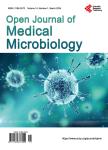Trends in Bacterial Blood Culture Isolates and Resistance in Children in Two Microbiologic Eras from a Tertiary Health Facility in North East Nigeria
Trends in Bacterial Blood Culture Isolates and Resistance in Children in Two Microbiologic Eras from a Tertiary Health Facility in North East Nigeria作者机构:Department of Paediatrics College of Medical Sciences Gombe State University Tudun Wada Nigeria Infectious Disease Training and Research Group Gombe (INDITREGO) Gombe Nigeria Department of Medical Microbiology College of Medical Sciences Gombe State University Tudun Wada Nigeria Department of Community Medicine College of Medical Sciences Gombe State University Tudun Wada Nigeria Microbiology Laboratory Federal Teaching Hospital Gombe Gombe Nigeria
出 版 物:《Open Journal of Medical Microbiology》 (医学微生物学(英文))
年 卷 期:2023年第13卷第2期
页 面:159-182页
学科分类:100208[医学-临床检验诊断学] 1002[医学-临床医学] 10[医学]
主 题:Trend Blood Culture Isolates Children Manual Bactec Resistance
摘 要:Introduction: Antimicrobial Resistance surveillance is predicated on blood culture as a priority clinical specimen in especially resource limited settings. Establishing trends in blood stream infections and resistance patterns can inform institutional and national policy on antimicrobial stewardship, surveillance, infection prevention and control. Methodology: Blood Culture isolates in children (0 - 18 years) by conventional method from 2008-2012 and Bactec Automated culture system from 2015-2020 were retrieved. Information analyzed included age, sex, month, and year and culture growth/identity of microorganisms and their sensitivity/resistance patterns. Clinical and Laboratory Standards Institute (CLSI) guideline for antibiotic susceptibility testing was used. Results: 20,540 children were admitted: 8964 (44.6%) and 11,630 (55.4%) in the Manual and Bactec blood culture era respectively. Blood cultures were done in 5271 in the manual culture era and 1077 in the Bactec culture era;of these cultures, 514 (9.7%) and 461 (42.8%) were positive for isolates in the respective era (p = 0.01). There were no statistically significant differences in trend between positive and negative blood cultures in males and females. Newborns, followed by children 1 - 5 years had more blood culture performed on them than other age categories. In general, there is no significant relationship in blood culture outcomes between the age categories and sex of the patients. The isolation of Staph aureus, Citrobacter and Alkaligenes increased two-fold with Bactec automated system. Resistance to the quinolones and the penicillin was high. Resistance trend to Genticin, an aminoglycoside was less than 40%. Resistance to Ceftazidime was high. Conclusion: Antimicrobial resistance surveillance is critical to reduce AMR related morbidity and mortality.



